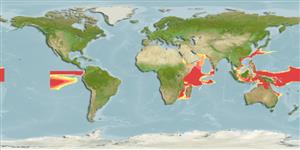>
Stomiiformes (Lightfishes and dragonfishes) >
Stomiidae (Barbeled dragonfishes) > Astronesthinae
Etymology: Astronesthes: Greek, astra = ray + Greek, esthes, -es = suit, something used to wrap (Ref. 45335); tchuvasovi: Named after Vladimir Mikhailovich Chuvasov, the leading technician of the Lab. Of Oceanic Ichthyofauna (IORAN), who is a diligent member of staff of the Laboratory and the author's companion on many research cruises (Ref. 27676).
Environment: milieu / climate zone / depth range / distribution range
Ecologia
marino. Tropical
Indo-Pacific: southern part of the Arabian Sea, the Flores and Banda seas, and the equatorial Eastern Pacific.
Size / Peso / Age
Maturity: Lm ? range ? - ? cm
Short description
Morfologia | Morfometria
Raggi dorsali molli (totale): 15-16; Raggi anali molli: 13 - 14; Vertebre: 46 - 48. In fish measuring 6 cm SL or more, aggregation of luminous tissue on head appear as a band across gill cover; one or several luminous patches on flanks, close to the medial line of body in advance of pelvic fin insertion. Chin barbel shorter than head, its swollen tip forming wide flattened lobe with oblique ribs and with small medial notch. It differs from other species of the group in having more vertebrae (Ref. 27676).
Life cycle and mating behavior
Maturità | Riproduzione | Deposizione | Uova | Fecundity | Larve
Parin, N.V. and O.D. Borodulina, 1996. Revision of the Astronesthes indicus species group (Astronesthidae), with descriptions of five new species. J. Ichthyol. 36(8):551-565. (Ref. 27676)
IUCN Red List Status (Ref. 130435)
Threat to humans
Harmless
Human uses
Informazioni ulteriori
Nomi ComuniSinonimiMetabolismoPredatoriEcotossicologiaRiproduzioneMaturitàDeposizioneSpawning aggregationFecundityUovaEgg development
Age/SizeAccrescimentoLength-weightLength-lengthLength-frequenciesMorfometriaMorfologiaLarveDinamica popolazioni larvaliReclutamentoAbbondanzaBRUVS
BibliografiaAcquacolturaProfilo di acquacolturaVarietàGeneticaElectrophoresesEreditarietàMalattieElaborazioneNutrientsMass conversion
CollaboratoriImmaginiStamps, Coins Misc.SuoniCiguateraVelocitàModalità di nuotoArea branchialeOtolithsCervelliVista
Strumenti
Special reports
Download XML
Fonti Internet
Estimates based on models
Preferred temperature (Ref.
123201): 20.9 - 28.6, mean 26.5 °C (based on 73 cells).
Phylogenetic diversity index (Ref.
82804): PD
50 = 0.5000 [Uniqueness, from 0.5 = low to 2.0 = high].
Bayesian length-weight: a=0.00417 (0.00171 - 0.01014), b=3.05 (2.83 - 3.27), in cm total length, based on LWR estimates for this (Sub)family-body shape (Ref.
93245).
Trophic level (Ref.
69278): 3.9 ±0.6 se; based on size and trophs of closest relatives
Resilienza (Ref.
120179): Alto, tempo minimo di raddoppiamento della popolazione meno di 15 mesi (Preliminary K or Fecundity.).
Fishing Vulnerability (Ref.
59153): Low vulnerability (10 of 100).
